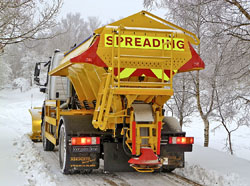5 September 2019
Bystronic plays a part in gritter manufacturer's successful 50 years
 Econ Engineering is the largest British manufacturer of gritters and salt spreaders, producing 360 units per year at its 88,000 sq ft factory, which opened in 1980 in Ripon, North Yorkshire. Additionally, it operates a growing hire fleet of currently more than 800 units which has boosted annual turnover to over £34 million, making the firm a major contributor to the local economy.
Econ Engineering is the largest British manufacturer of gritters and salt spreaders, producing 360 units per year at its 88,000 sq ft factory, which opened in 1980 in Ripon, North Yorkshire. Additionally, it operates a growing hire fleet of currently more than 800 units which has boosted annual turnover to over £34 million, making the firm a major contributor to the local economy.
In fact, in its 50th year, Econ is experiencing an unprecedented order book, partly fuelled by recent harsher winters, but also due to the multibody products that allow customers to utilise one chassis for multiple tasks, such as road repair as well as winter maintenance, making the investment usable throughout the year.
Bystronic, is proud to have played a part in helping Econ, for nearly one-third of its 50-year existence, to maintain the high level of component accuracy that underpins its reputation for top quality.
The initial credit for this success story goes to the late Bill Lupton, who started Econ Engineering in the autumn of 1969 on an old brewery site in Ripon. 2003 saw the second generation of Luptons – Jonathan and Andrew – take over running the company. They were instrumental in developing contract hire for gritters and snowploughs at a time when public spending cuts were making new equipment purchase difficult.
It was in the early 2000s that the first Bystronic laser machine replaced a turret punch press and a plasma profile cutter for processing the majority of components made from mild steel plates. The laser machine, a ByStar 4020 with a 4 kW CO2 power source greatly increased production efficiency and component accuracy.
The current laser machine, which was installed in 2014, works 24/7 processing up to 35 tonnes of steel a week into any of 87,000 different components produced in batch sizes ranging from 5- to 30-off and to an accuracy in some cases down to ± 0.5 mm. With such a large variety of part numbers, extensive use is made of modern MRP (manufacturing resource planning) software as well as colour coding of components on the shop floor according to their material type, thickness and product type.
- Contact Information
- Name: Daniel Thombs
- Email: daniel.thombs@bystronic.com
- Website: www.bystronic.com

